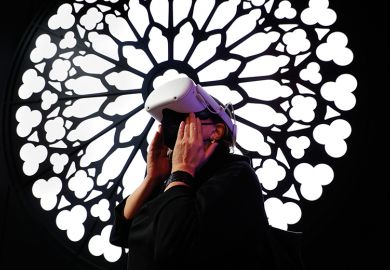Picture the scene: Professor X, given 15 minutes to present his latest research at a major international symposium, delays proceedings for 10 minutes as he, the chair and the discussant all cluster around the podium, trying to understand why PowerPoint is not working. The audience shift restlessly in their seats as the chair apologises once again for the technical problems and some leave for another panel.
At a PhD workshop, student Y, already nervous about presenting to his peers and the staff of the department, visibly sweats as the equipment fails to work. For some reason, the computer is just not talking to the projector. Three members of staff and another PhD student bustle around him, pushing buttons and flicking switches, alternately staring at the screen and the projector. The audience shift restlessly in their seats as the chair apologises once again for the technological problems. Eventually the computer experts are called, and everything comes to a halt while we wait for them to trudge across campus and fiddle around some more with buttons and switches. (“Have you tried turning it off and turning it on again?”)
Unfortunately, this is becoming an all-too familiar scene in a profession where overdependence on PowerPoint and other forms of presentation jiggery-pokery is now not only expected, but is also considered the norm. Indeed, I have delivered papers where the audience have almost gasped in collective horror at the idea they will not have text to read on the screen, but will instead have to look at me as I speak without PowerPoint about my research. When did academics lose the capacity to discuss their research without preparing slides?
More importantly, are we explaining to the next generation that they should be able to deliver a meaningful presentation about their research even when the technology fails to work? It is important that our PhD students understand that sometimes things go wrong; that the computer refuses to work or read the file on the USB, or that the laptop you expected to be in the room is not there on the day. We need to advise our students (and increasingly our colleagues) that they need a back-up plan, perhaps with some notes (dare I whisper these words in our technology-driven world?) on paper, and that it is OK to begin your presentation while the computer is being fixed, or even avoid using PowerPoint altogether.
Of course the overdependence on technology is annoying and distracting in myriad other ways: the all-singing, all-dancing PowerPoint slides with machine-gun sound effects that accompany every letter that literally spins on to the screen, meaning that just the title of the presentation takes almost five minutes to appear (I kid you not – I recently witnessed a professor prepare such a presentation at a major international conference); the commitment to filling every available space on the screen with text of ever-decreasing font size; or, arguably most annoying of all, the presenter who turns his back on the audience and simply reads reams of text from the screen. All are observed examples of a serious decline in the ability of academics to communicate their research. Is the focus on the presentation covering the lack of substance and intellectual rigour?
Of course PowerPoint and other presentation tools are useful, but they are simply that – tools. I use them to display photos, diagrams, maps and tables, sometimes to play a video clip. You could never do this with an overhead projector and transparencies. (Remember the fuss of preparing them?) There are even times when, depending on the audience I am addressing, I decide it is necessary to add a few bullet points to a slide. But I am confident that, having written some notes (on paper, sometimes with a pen) the show will go on even if the technology lets me down. I hope that I am in sufficient command of my subject to be able to speak about it for 10 minutes, if not longer.
When we are training our PhD students in the art of presentation, are we giving them the necessary advice – the confidence – that will allow them to avoid an addiction to PowerPoint and ensure that they may experiment with using it less or not at all? At the very least are we making sure they are adequately prepared to still deliver a meaningful presentation even when the computer stops talking to the projector? If experienced academics cannot communicate without PowerPoint, how do we expect our students to do so?
Gary Rawnsley is professor of public diplomacy and director of international academic strategy at Aberystwyth University.
Register to continue
Why register?
- Registration is free and only takes a moment
- Once registered, you can read 3 articles a month
- Sign up for our newsletter
Subscribe
Or subscribe for unlimited access to:
- Unlimited access to news, views, insights & reviews
- Digital editions
- Digital access to THE’s university and college rankings analysis
Already registered or a current subscriber? Login







